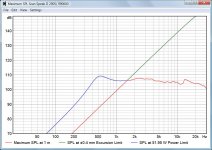I need a rough estimate of expected tweeter excursion at the top end of the audible frequency range (call it 20 kHz). Anybody have some data? I would assume a small ported box if that matters.
My question has nothing to do with music. If I drove a high-quality tweeter continuously with a 20 kHz signal at "max" excursion it could sustain without burning up, what would you estimate that excursion would be?
That information should be in the driver's data sheet, for example: http://www.troelsgravesen.dk/PRELUDE_files/9900.pdf
Right, I see Xmax on some datasheets but I don't know enough about speaker specifications to know if that's frequency-independent.
I would assume mounting on a flat baffle. The Revelator referenced above shows linear excursion of 0.4 mm, which implies peak-to-peak displacement of 0.8 mm. Could I actually get that much excursion at 20 kHz without burning the thing up? I'm not looking for a specific dB so much as I am trying to create high frequency displacement (like a linear motor).
I would assume mounting on a flat baffle. The Revelator referenced above shows linear excursion of 0.4 mm, which implies peak-to-peak displacement of 0.8 mm. Could I actually get that much excursion at 20 kHz without burning the thing up? I'm not looking for a specific dB so much as I am trying to create high frequency displacement (like a linear motor).
Max mechanical excursion I have seen in a tweeter is 1.5mm and about 1/3 of that while remaining linear but certainly not at 20k. At 20k it's probably only 0.05, if that. Just a guess.
0.05 mm would be fantastic. Thanks for the guess! It's more informed than my own, that's for sure.
If the frequency response is flat the excursion will be the same at all frequencies. The baffle dimension is of little relevance at 20kHz
Jimmy, your main concern is how much heat can the tweeter voice coil take without getting fried. Excursion az 20 kHz is very small but the current that may burn the coil is in the 1-1,5 A region approximately.
Interesting. Assuming flat frequency response, would the input power requirement to achieve max excursion be independent of frequency, too?
The higher the frequency, the less excursion for the same spl is needed. You will burn the coil long before you make it swing maximally.
OK, thanks. Let's take a single example: the Revelator referenced earlier. How would I go about estimating its continuous allowable excursion for a 20 kHz input signal? Would this involve specifying maximum current and then calculating the mechanical response to that current?
The current is what you need to worry about. As the heats builds up, the wire enamel starts cooking until it burns up and the coil shorts. I don't have the formula at hands for estimating excursion at a desired frequency.
If the peak to peak signal is the same at different frequencies wouldn't the excursion also be the same, given flat FR?
I'm sorry scottjoplin, I don't know where you got that idea. Flat frequency response is a decription of sound output, not diaphragm travel. Lower frequencies require more travel of the diaphragm(with same area), hence the trouble crossing smaller(or those with less travel) drivers as low as larger ones.
Last edited:
I understand that, but if the peak to peak voltage input is the same at different frequencies wouldn't the voice coil travel be the same? I think that is what I'm trying the ask/say
Yes, but signal isn't the same for same SPL. More power is needed for lower frequencies.If the peak to peak signal is the same at different frequencies wouldn't the excursion also be the same, given flat FR?
- Status
- Not open for further replies.
- Home
- Loudspeakers
- Multi-Way
- Tweeter excursion
